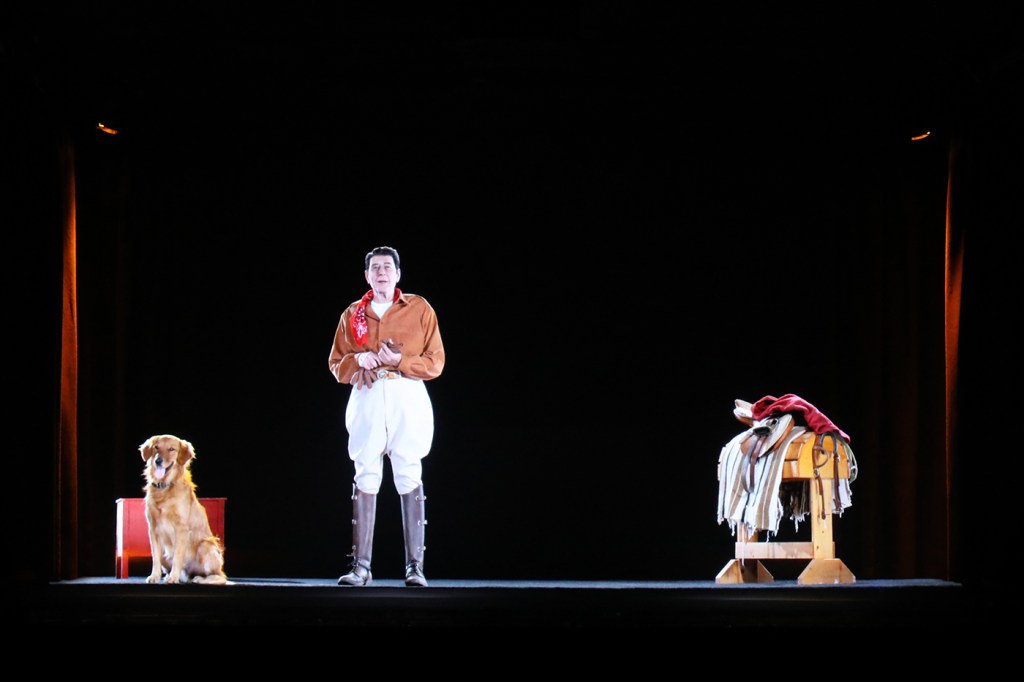Northeastern University graduate resurrects President Reagan as a digital hologram

The people who happened to witness it because they were stuck in the traffic-congested freeways of Los Angeles that afternoon couldn’t believe their eyes: Was that President Ronald Reagan riding shotgun in a Hyundai Tucson? In 2018?

Dan Lux graduated from Northeastern in 1986 with an electrical engineering degree, but went on to have a successful career in the entertainment business before moving to New Orleans to work primarily on hologram projects. Courtesy of Dan Lux
Behind the wheel of the Hyundai was Dan Lux, who, unbeknownst to the commuters, was on a mission. He had carefully propped a silicone bust bearing a “picture-perfect” likeness to the president on a stand in the passenger’s seat and draped a seatbelt over it. Lux was taking the bust from a studio to a film set, where it would be scanned to create a hologram that’s now on permanent display at the Ronald Reagan Presidential Library and Museum in Simi Valley.
“At the light people would stop and look like it was a presidential motorcade and they would give it a second look because it looked that real,” said Lux, a Northeastern graduate who helped produce the hologram exhibit. “It was like I had Reagan in my car.”
Holograms attracted widespread attention in the United States in 2012, when a digital rendition of the late rapper Tupac Shakur was projected onto a stage at the Coachella Valley Music and Arts Festival. Since then, the technology has improved and the appetite for digitally repurposed icons has grown, said Lux, paving the way for a digital resurrection of Reagan that was unveiled to the public last fall.
In a first-of-its-kind exhibit, the 40th commander-in-chief is portrayed in three vignettes, each set at a different point in his presidency. The first is from his Whistlestop Train Tour during the 1984 presidential election, while the second shows him at Rancho del Cielo, his home near Santa Barbara. The final vignette shows the Republican president in the Oval Office.
Lux said he believes that as a politician who was always pushing for technological advancements, whether it was the NASA program or the Strategic Defense Initiative, Reagan would have probably appreciated the exhibit.
“People that knew him the best say he would love this,” said Lux. “He would have loved the fact that it merges an element of Hollywood production with technology and in pioneering new grounds.”
Lux is one of nearly 70 people who were involved in the complex effort to bring the beloved president to life in digital form. It took him and his team two years of planning, experimenting, and overcoming significant technological hurdles to design the most realistic three-dimensional portrayal of a president to date.
“Every single step of the way had its own challenge,” he said.

Lux and his team had to first find a body double with similar facial proportions and mannerisms as Reagan, an arduous task that required screening thousands of candidates from all over the world. Once they identified the right actor, they captured his movements on film before digitally superimposing an animated head on the body.
The hologram was produced with the help of computer-generated imagery created by Digital Frontier FX and a 19th century special effects technique called Pepper’s Ghost. The hologram’s facial expressions were synced to actual audio recordings of Reagan. Speeches and old footage were used as references.
“Much of the 3-D effect takes place in the inner recesses of your brain, because what happens is you see what’s fundamentally a 2-D image but it’s set in amongst three-dimensional objects, such as stage props,” said Lux. “And your brain, when it sees that, it processes everything as being three-dimensional. That’s where the magic takes place.”
Unlike the iterations preceding it, such as the holographic performances featuring Tupac or Roy Orbison, the Reagan hologram can be seen from a close distance and it plays continuously all day. The audience response thus far has been “far beyond anyone’s expectations,” said Lux.
“President Reagan carries a rather big presence and when, even in a hologram form, enters a room, there’s that weight that comes with it,” he said. “So it’s really been an extraordinary success for the library, particularly with the younger generation. This kind of technology really appeals to them, and it opens their eyes to a figure that they probably have never even heard of or just heard of very rarely.”
It’s been an unlikely career trajectory for Lux. After graduating from Northeastern with an electrical engineering degree in 1986—in the middle of Reagan’s second term—he moved to California to work at an import distribution company before realizing he had a passion for the entertainment industry.
Over the span of his career, he has worked with the likes of Madonna, helping to launch the television division of her multimedia company in the 1990s. He has also worked as a television movie producer before switching gears to work on reality shows. Today, he lives in New Orleans and works primarily on hologram projects. He has also written a book titled “Soul School: The Purpose of Life Revealed,” which he described as “a blend of quantum physics and spirituality.”
“Ultimately I ended up in the entertainment business which has very little to do with electrical engineering, but [Northeastern] provided me with a foundation of being able to set goals and achieve goals, and it laid down a foundation of organization that allowed me to multi-task and become the success that I had in the entertainment industry,” he said.
For media inquiries, please contact media@northeastern.edu.





